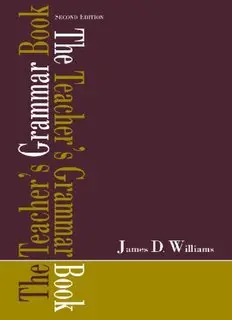
The Teacher’s Grammar Book PDF
Preview The Teacher’s Grammar Book
The Teacher’s Grammar Book Second Edition The Teacher’s Grammar Book Second Edition James D. Williams Soka University LAWRENCE ERLBAUM ASSOCIATES, PUBLISHERS 2005 Mahwah, New Jersey London Copyright © 2005 by Lawrence Erlbaum Associates, Inc. Allrightsreserved.Nopartofthisbookmaybereproducedinanyform, byphotostat,microform,retrievalsystem,oranyothermeans,without prior written permission of the publisher. Lawrence Erlbaum Associates, Inc., Publishers 10 Industrial Avenue Mahwah, New Jersey 07430 www.erlbaum.com Cover design by Kathryn Houghtaling Lacey Library of Congress Cataloging-in-Publication Data Williams, James D. (James Dale), 1949– The teacher's grammar book / James D. Williams.—2nd ed. p. cm. Includes bibliographical references and index. ISBN 0-8058-5221-2 (pbk. : alk. paper) 1. English language—Grammar. 2. English language—Grammar— Study and teaching. I. Title. PE1112.W462005 428.2—dc22 2004056421 CIP BookspublishedbyLawrenceErlbaumAssociatesareprintedonacid-free paper, and their bindings are chosen for strength and durability. Printed in the United States of America 10 9 8 7 6 5 4 3 2 1 Contents Preface ix Acknowledgments xiii 1 A Short History of Grammar 1 Agreeing on a Definition 1 Greek Beginnings 2 Grammar in Rome 5 Grammar in the Middle Ages 7 The Age of Enlightenment 9 The Age of Reason 12 Modern Grammars 15 2 Teaching Grammar 17 Recognizing the Challenges 17 Learning Outcomes 19 Grammar and Writing 23 Why Teach Grammar? 40 Best Practices 41 Suggested Activities 47 v vi CONTENTS 3 Traditional Grammar 50 Prescriptive Grammar in Our Schools 50 Form and Function in Grammar 53 Subjects and Predicates 54 Nouns 59 Pronouns 60 Verbs 70 Modifiers 77 Function Words 82 4 Phrase Structure Grammar 97 From the Universal to the Particular 97 Phrase–Structure Rules 101 Tree Diagrams 107 Coordination 114 Progressive Verb Forms 130 Perfect Verb Forms 133 Possessives 133 Restrictive and Nonrestrictive Modification 134 Subordinate Clauses 136 Complement Clauses 139 Relative Clauses 142 Negatives 152 Nonfinite Verb Forms 154 Summary of Phrase–Structure Rules 156 5 Noam Chomsky and Grammar 161 The Chomsky Revolution 161 Deep Structure and Surface Structure 166 The Basics of Transformation Rules 169 Relative Clause Formation 174 The Minimalist Program 162 A Critique of the Minimalist Program 191 6 Cognitive Grammar 197 What Is Cognitive Grammar? 197 Modularity 198 Determining Meaning 199 Cognitive Grammar and Language Acquisition 206 CONTENTS vii 7 Dialects 220 What Is a Dialect? 220 How Do Dialects Develop? 221 Students and Dialects 224 Slang 228 Development of a Prestige Dialect 230 Nonstandard Dialects 230 Dialects and Education 233 Black English 236 Chicano English 245 Chicano English Grammar 246 Chicano English in the Classroom 248 Spanglish 250 Code Switching 250 References 254 Index 265 Preface TheTeacher’sGrammarBookisdesignedforstudentswhoarepreparingtobe- come English or language arts teachers, as well as for credentialed teachers whowanttoknowmoreaboutgrammar.Mostgrammarbooksfocusontermi- nology.Someaddadiscussionoftheconnectionbetweengrammarandwrit- ing. The Teacher’s Grammar Book, however, is different. Certainly, it treats terminologythoroughly,butitisfarmorethanjustalistofgrammarterms.Itis not a handbook and was never intended to be one. The Teacher’s Grammar Book was designed to offer an easy-to-use guide to teaching methods and grammarandusagequestions,acombination thathasnotbeenreadilyavail- ablebefore.Inaddition,itprovidesanoverviewofEnglishgrammarthatisin- formednotonlybyhistoricaldevelopmentsinthefieldbutalsobyavarietyof pedagogical,research,andphilosophicalissuesthatunderliegrammarandour efforts to understand grammar, language, writing, and teaching. Out of this wide-rangingexplorationemergestheviewthatateacher’schoiceofgrammar reflectsphilosophicalandpedagogicalorientationsthatinfluenceboththecon- tent and the methods of language arts instruction. TheTeacher’sGrammarBookgrewoutofmyexperienceteachinggrammar andcompositionmethodscoursestoeducationstudentssince1981.WhatIdis- coveredearlyinmycareeristhatlargenumbersofprospectiveteachersdonot feelconfidentabouttheirknowledgeofEnglishgrammar.Theyexperiencea certaindegreeofanxietyasaresult.Mosthaverecognizedthattheywillbere- quiredtoteachgrammar—andtheyaren’thappyaboutit.Manyhavehadbad experienceswithgrammarinthepast.They“didn’tgetit,”or,sadderstill,they “justdidn’tlikeit.”Nearlyallaresurprisedwhen,afewweeksintomygram- marcourses,theydiscovernotonlythattheyare“gettingit”butthatgrammaris ix x PREFACE actually fun.TheTeacher’sGrammarBook aimstotakereadersonasimilar voyage of discovery. What’s New in the Second Edition The many teachers and students who used the first edition of The Teacher’s GrammarBookprovidedvarioussuggestionsovertheyearsintendedtomake thetextbetter.I’vetriedtoincorporatetheirsuggestionsintothesecondedition asmuchaspossible,andIhopetheyarehappywiththeresultofthisindirect collaboration.Inmanyrespects,thefinishedproductissignificantlydifferent from the original. The more important changes are: • Anewchapterprovidingashorthistoryofgrammaranditsroleineducation. • Anewchapteronteachinggrammarthatexaminesnotonlythechallenges teachersfacebutalsowhatresearch,theory,andclassroomexperiencetellus constitutes “best practices.” • A significant reduction in the formalism associated with phrase structure grammarsoastofocusmoreonthedescriptivegoalsofthisapproachtolan- guage analysis. • Acompleterevisionofthechapterontransformational–generativegrammar thatsignificantlyreducesthediscussionoftransformationrulesandtreedia- gramssoastofocusmoreonotherfeaturesofthisapproach,suchasitsinflu- enceonteachingandpsychology;alsonewisasummaryofthemodel—the minimalist program—that Noam Chomsky developed to replace trans- formational–generative grammar. • Acompleterevisionofthechapteroncognitivegrammarthatnotonlymakes thediscussionmorecurrentbutalsomoredetailed,addressinghowcognitive grammarprovidesinsightintocommonproblemsassociatedwithteaching writing, such as creating meaning and errors in language. • Athoroughrevisionofthechapterondialectstomakeitbothmorecurrent and more detailed; the discussion of Chicano English is significantly ex- panded,andnewinthiseditionisabriefanalysisofSpanglishandanexplo- ration of code switching. • Also new is the focus on teaching grammar and language as a thread that windsthrougheachchapter,makingthetextmorethoroughlyatooltohelp teachers meet the challenge of grammar instruction. Chapter One. Thefirstchapteroffersabriefhistoryofgrammarinthe Westerntradition.Althoughtherearesomeinterestingstoriestotellaboutthe studyofgrammarinplaceslikeIndia,China,andtheMiddleEast,theyarenot veryrelevanttoAmericanpubliceducation,basedasitisonGreekandRoman models.Thegoalofthischapter,therefore,istogivereadersasenseoftheplace PREFACE xi grammarhasheldinWesterneducationsincethedaysofPlatoandAristotleso thattheycanbetterunderstandandappreciatewhyweexpectstudentstolearn something about the English language. Chapter Two. Chapter2exploresvariousapproachestoteachinggram- mar, and in many respects it is central to developing an effective classroom methodology.Therearemanydifferentwaystoteachgrammar,andthischap- terexaminesthemostcommon,assessingtheirstrengthsandweaknesseswith the aim of identifying best practices. Centraltothischapteristhesectionongrammarandwriting.Mostteachers andmanytextbooks,suchasWeaver’s(1996)TeachingGrammarinContext andNoden’s(1999)ImageGrammar:UsingGrammaticalStructurestoTeach Writing,advocateteaching grammarinthecontextofwriting.However,few recognizethedifficultiesandfaultyassumptionsinherentinthisapproachasit usuallyisapplied.Emphasizingthelinguisticperspectivethatinformstheen- tirebook, this section makesan important distinction between grammarand usage,explainingwhymostofthesentenceerrorsweseeinstudentwritingare notproblemsofgrammarbutratherproblemsofusage.Animportantfeatureof TheTeacher’sGrammarBookaretheUsageNotesthatappearatkeypointsto explainawiderangeofcommonusageproblems.Finally,thechapterexamines existing research and explores the most pedagogically sound ways to link grammar and writing. Chapter Three. Althoughchapter2isimportantforeveryEnglish/lan- guageartsteacher,chapter3,“TraditionalGrammar,”maybeevenmoreim- portantbecauseitprovidesthefoundationforactuallyteachinggrammar.The subsequentchaptersarebuiltonthisfoundation,andtogethertheywillelimi- nateanylackofconfidencereadersmayhaveabouttheirknowledgeofgram- mar. The chapter begins by introducing basic grammatical terms and explainingtheirroleinlanguagestudy.Itdoesnotassumethatreadershaveany significantknowledgeofgrammaratallsoastocreateacomfortablespacefor learning.Takingastandardapproach,grammarisdividedintotwocategories of analysis,formandfunction. Chapter 3 also builds on the grammar/usage distinction by introducing a fundamentalfeatureofmodernlanguagestudy—appropriatenessconditions. BasedinpartonHymes’(1971)principlesofcommunicativecompetence,ap- propriatenessconditionscontextualizelanguageuseandallowstudentstoun- derstandmorethoroughlythefactorsthatmakewritingdifferentfromspeech and that enable us to recognize that the language we use when talking with friendsoverpizzaandbeerwillbedifferentfromthelanguageweuseduringa
